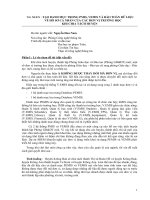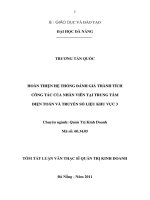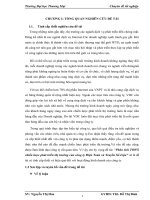Ch00 introduction TRUYỀN SỐ LIỆU VÀ MẠNG
Bạn đang xem bản rút gọn của tài liệu. Xem và tải ngay bản đầy đủ của tài liệu tại đây (754.29 KB, 9 trang )
Data Communication and
Networking
Dr. –Ing. Vo Que Son
Email:
Telecomm. Dept.
Faculty of EEE
DCN
HCMUT
1
Content
Credit: 3
Grading Policy:
Midterm Exam:
Experiment:
Final Exam:
20%
20%
60%
PI Assessment: a1 (ABET criteria) on Midterm and
Final exams
Reference:
[1] Communication Networks, Leon-Garcia
[2] Computer Networking: A Top Down Approach Featuring the Internet, J.F Kurose et al.
[3] Data Communication and Networking – Behrouz A. Forouzan
[4] Data Communications, Computer Networks and Open Systems, Fred Halsall
[5] Lecture notes
The course slides are also prepared in combination with the use of other information sources.
Telecomm. Dept.
Faculty of EEE
DCN
HCMUT
2
Course Outcomes and Program Outcome
No
Course learning outcomes (Theory)
CDIO
ABET
L.O.1 Understanding background of transmission media and PHY 2.1, 2.2, 2.3 a1(P), e2(S)
layer, and applying knowledge of physical interface standards
in data transmission
L.O.2 Deeply understanding basic data transmission techniques:
2.1
a1(P), e1(S)
asynchronous and synchronous data transmission, error
detection and correction, source coding
L.O.3 Clearly understanding basic protocols of data link layer and
2.1, 2.3
a1(S), e1(S)
can be able to build communication protocols in reality
L.O.4 Understanding telco networks, IP networks and being able to
apply in reality
L.O.5 Be able to build simple data networks, and manage network
devices
2.1, 2.3,
2.4, 4.1
2.2, 2.3,
3.1, 4.3
e2(S), e3(S)
b2(S), b3(S)
ABET Criteria a: An ability to apply knowledge of mathematics,
science, and engineering
- PI a1: Use probability and statistics to model situations in engineering
Telecomm. Dept.
Faculty of EEE
DCN
HCMUT
3
Content
Chapter 1: Medium and PHY Layer
Wired and Wireless Media
Physical layer standards: RS232, RS422, RS485
Line Coding
Digital modulation/demodulation
Channel parameters
Gaussian noise and BER
Chapter 2: Data Communications
Asynchronous data transmission
Synchronous data transmission
Channel Coding
Data Compression
Telecomm. Dept.
Faculty of EEE
DCN
HCMUT
4
Content
Chapter 3: Data Link Layer Protocols
Flow Control
Error Control
Connection Management
Data link layer Protocols
Chapter 4: Communication Networks
Introduction to communication networks
802.x standard and TCP/IP Model
Ethernet, Token Pass, Token Ring
IP Addressing: Classless and VLSM
Network devices
Switching and Routing
STP, VLAN
Telecomm. Dept.
Faculty of EEE
DCN
HCMUT
5
Content
Chapter 5: Industrial Networks
MODBUS
CAN (Controller Area Network)
SCADA (Supervisory Control And Data Acquisition)
Telecomm. Dept.
Faculty of EEE
DCN
HCMUT
6
OSI Model
What is OSI model?
Open System Interconnection
Why do we have to use OSI
model?
System and Device Design
Trouble-shooting
OSI model:
PHY layer
MAC layer
Network layer
Session layer
Presentation layer
Application layer
Telecomm. Dept.
Faculty of EEE
DCN
HCMUT
7
OSI Model: Layer Functions
Telecomm. Dept.
Faculty of EEE
DCN
HCMUT
8
Communication in OSI model
At each level, two entities (N-entity peers)
interact by means of the N protocol by
transmitting protocol data units (PDU).
A service data unit (SDU) is a specific unit
of data that has been passed down from an
OSI layer to a lower layer, and which the
lower layer has not yet encapsulated into a
protocol data unit (PDU). An SDU is a set of
data that is sent by a user of the services of
a given layer, and is transmitted
semantically unchanged to a peer service
user.
The PDU at a layer N is the SDU of layer N1. In effect the SDU is the 'payload' of a
given PDU. All the data contained in the
SDU becomes encapsulated within the
PDU. The layer N-1 adds headers or
footers, or both, to the SDU, transforming
it into a PDU of layer N-1. The added
headers or footers are part of the process
used to make it possible to get data from a
source to a destination.
Telecomm. Dept.
Faculty of EEE
DCN
HCMUT
9









